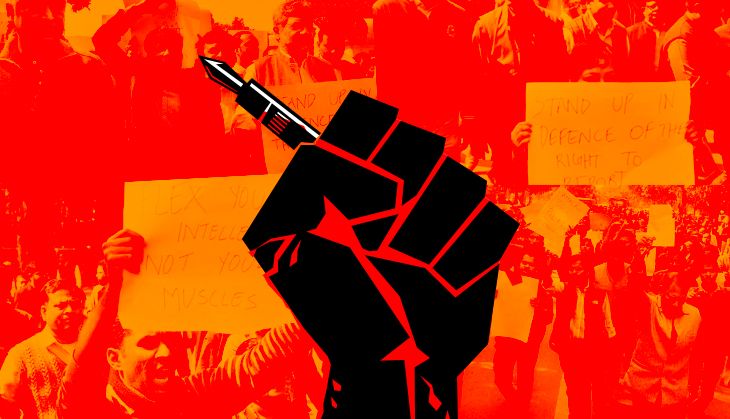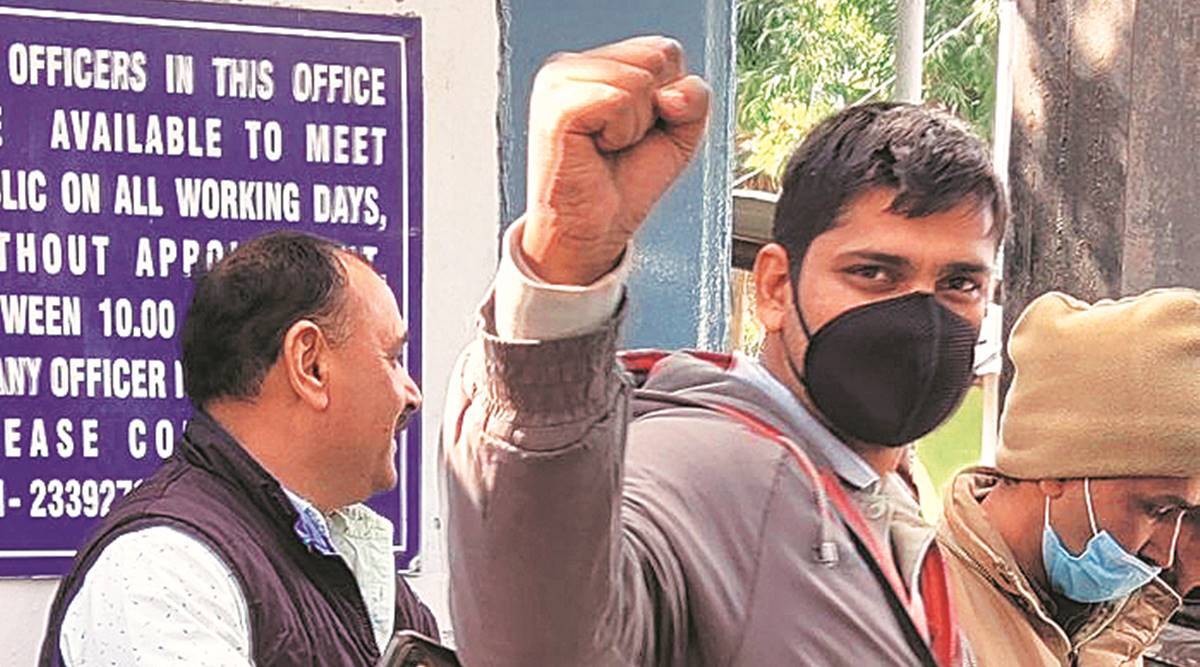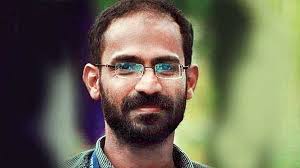
There is a systematic campaign against press freedom in India, and its effects are chilling, writes MONICA DHANRAJ. A number of journalists have been charged with serious criminal offices due to their recent social media posts related to the death of anti-farm law protester Navreet Singh. These FIRs have caused an uproar. Press bodies have condemned them as an attack on journalists.
ON January 28, the Uttar Pradesh police registered FIRs against senior journalists Mrinal Pande, Rajdeep Sardesai, Vinod Jose, and Zafar Agha, and against Paresh Nath and Anant Nath, the editors of Caravan magazine, as also against Congress Member of Parliament Shashi Tharoor. The ostensible reason was their comments on social media related to the death of protester Navreet Singh on January 26 during the farmers’ tractor parade.
Some eye-witnesses had claimed at the time that Singh was hit by a bullet, allegedly fired by the police. The police have denied this and released a video recording of the tractor Singh was driving overturning as it reached a barricade. His post-mortem report lists the cause of death as “shock and hemorrhage as a result of antemortem head injury”.
The first FIR registered by Uttar Pradesh Police on January 28 charged the seven under sections 124A (sedition), 295A (deliberate and malicious acts intended to outrage religious feelings of any class by insulting its religion or religious beliefs), 504 (intentional insult with intent to provoke breach of the peace), 506 (criminal intimidation), 34 (acts done by several persons in furtherance of common intention), 120B (criminal conspiracy) of the Indian Penal Code and under provisions of the Information Technology Act, 2000.
Similar FIRs have been filed against all seven, with near-identical provisions, by Madhya Pradesh, Karnataka, Haryana, and Delhi Police.
Freelance journalist Neha Dixit recently reported an attempted break-in. She said he was being stalked since September 2020. The stalker would identify her ‘exact physical location’ through phone calls, threaten ‘rape, acid attack, and death’. Dixit has often been targeted for her reporting.
On January 30, Delhi Police detained freelance journalist Mandeep Punia and Dharmender Singh, who had been covering the farmer agitation at the Singhu border in Delhi.
Punia, who has contributed to Caravan magazine, was gathering information about the violence that occurred at the protest site a few days earlier. A video, which apparently shows him being dragged away by the police went viral.
While Dharmender Singh was released the next morning, after signing an undertaking that he would not do “such things” again, an FIR was registered against Punia at the Alipur Police Station at around 1:20 am.

Punia was booked under sections 186 (obstructing public servant in discharge of his public functions), 332 (voluntarily causing hurt to deter public servant from his duty), and 353 (assaulting or using criminal force to deter public servant from discharge of his duty) of IPC.
The same day, journalist Ismat Ara wrote about Navreet Singh’s death on the online platform, The Wire. The article presented the family’s version of the incident. Wire editor Siddharth Vardarajan tweeted a link to the article along with a comment from the family.
A day later, the police in Rampur, Uttar Pradesh, registered an FIR against Vardarajan under sections 153-B (imputations, assertions prejudicial to national integration) and 505(2) (statements conducing to public mischief) of IPC. Importantly, The Wire is the only news portal to have published a full article detailing the family’s version.
The Indian Women’s Press Corps, Press Club of India, Press Association, Delhi Union of Journalists, Editors Guild of India, and others issued statements condemning the FIRs. Popular social media platform Twitter suspended the accounts of multiple activists, academics, and groups that are protesting the laws, following a request under Section 69A of the IT Act from the Ministry of Electronics and Information Technology. A day later, Twitter restored the accounts.
In 2017, journalist Gauri Lankesh was killed after being labeled a “Hindu hater”. In June 2018, an online blog named Kashmir Fight accused Rising Kashmir editor Shujaat Bukhari of “betraying the Kashmir struggle”. Eleven days later, he was shot dead outside his office.
DO NOT BE SHOCKED YET!
In October last year, the Committee to Protect Journalists released its Global Impunity Index 2020, Getting Away With Murder. It spotlights countries in which journalists are murdered and their killers go free. Only nations with five or more such unsolved cases are included on the index, which only tallies murders carried out with complete impunity. It does not include cases in which there has been partial justice.
India is ranked 12 on the index, becoming one of only seven countries that have always featured on it since its first edition in 2008. This is not an index that any democracy— especially the world’s largest one—ought to be on.
Also Read: Idea of Republic is Just an Abstract One
Terrifying as it is, India’s presence on this list scratches only the surface of the press freedom (or lack thereof) in India. The index only accounts for those murders of journalists that have taken place in retaliation for their work. It excludes other tactics commonly deployed to muzzle freedom of the press.
In 2020 alone, a wide range of coercive actions was employed against journalists in India for doing their job.
COMING DOWN HARD WITH CRIMINAL LAW
In March last year, the central government announced a lockdown due to the COVID-19 pandemic. Journalists risked their health and safety to report extensively on the crisis. They were rewarded for their efforts with criminal complaints, defamation suits, harassment, and threats.
The COVID-19 crisis has given the police a new weapon—they now started charging journalists under the Disaster Management Act, 2005 as well, in addition to the IPC.
Two FIRs registered against Wire editor Siddharth Varadarajan by Uttar Pradesh Police charged him with promoting enmity and disobedience of a public servant’s order and laws relating to impersonation and transmission of obscene material. Then the state police travelled 700 km to serve him with a notice despite strict restrictions on movement during the lockdown.
In April 2020, Uttar Pradesh Police served Varadarajan, editor of The Wire, with a notice under Section 41(A) of the Criminal Procedure Code, 1973. It cited an FIR registered by Faizabad Police charging Varadarajan with making an “objectionable” remark about Uttar Pradesh Chief Minister Yogi Adityanath.
Two FIRs registered against Varadarajan charged him with Section 505 (creating or promoting enmity, hatred, or ill-will between classes) and Section 188 (disobedience to order duly promulgated by a public servant) of the IPC and sections of the Information Technology Act, 2000 dealing with impersonation and transmission of obscene material.
The Uttar Pradesh Police thought it is an urgent enough matter to travel 700 km from Ayodhya to Delhi to serve Varadarajan during the first phase of the lockdown when there were strict restrictions on movement.
The same month, the Cyber Police Station in Srinagar registered a case under the stringent Unlawful Activities (Prevention) Act, 1967 (UAPA) against photojournalist Masrat Zahra for posting her already-published works over the years, on social media. Zahra was booked under Section 13 of UAPA (taking part or committing, or advocating abetting, advising or inciting the commission of, any unlawful activity) and Section 505 of the IPC (statements conducing to public mischief).
The police said in its statement related to Zahra’s case that it had received information through reliable sources that one Facebook user, namely, Masrat Zahra, is uploading anti-national posts with “criminal intent” and that the posts had the “potential to provoke the public to disturb the law and order”.
Also Read: Media Policy 2020: Mocking Freedom of Speech and Expression in Jammu and Kashmir
In the same week, the Srinagar police summoned senior journalist Peerzada Ashiq, a reporter with The Hindu newspaper, for interrogation. This was with regards to his news report about an encounter that took place in Shopian in South Kashmir. The police said that the details in the report were factually incorrect and published without seeking confirmation from district authorities.
In May, Dhaval Patel, editor of Gujarat-based news portal, “Face of the Nation”, was booked by the state police for “sedition” and under Section 54 (making or circulating a false alarm or warning as to disaster or its severity or magnitude, leading to panic) of the Disaster Management Act.
This was for a story that suggested that the Bharatiya Janata Party was looking to replace state Chief Minister Vijay Rupani due to the alleged mishandling of the COVID-19 crisis. The Ahmedabad Sessions Court granted bail to Patel on May 27 last year, after it found “no such prima facie serious offence” was made out.
On October 5 last year, Siddique Kappan, a journalist and Delhi unit secretary of the Kerala Union of Working Journalists was arrested along with three others in Mathura, Uttar Pradesh, while they were on their way to cover the alleged gangrape and murder of a young woman in Hathras.
An FIR was lodged, charging them for laws dealing with sedition, promoting enmity between groups, and outraging religious feelings and under the UAPA, other than sections 65, 72, and 76 of the IT Act.
The state police claimed that the four men were stopped at a toll after they received information about “suspicious people” heading to Hathras from Delhi.

According to the police statement, a laptop, mobile phones, and some literature, which “could have an impact on peace, and law and order in the state” were seized from them.
Ten days later, Ahan Penkar, a reporter for the Caravan magazine, was assaulted by Delhi Police while he was reporting in North Delhi. Penkar alleged that Assistant Commissioner, Delhi Police, Ajay Kumar kicked and slapped him inside Model Town Police Station though he repeatedly told the police he was a journalist.
The police forcibly took Penkar’s phone and deleted all the videos he had recorded while reporting. Penkar was detained for nearly four hours and sustained injuries on his nose, shoulder, back, and ankle. A day later, the office of the DCP, North West Delhi, claimed on Twitter that Penkar was “seen protesting amongst the crowd” and violating laws invoked during the pandemic.
MENTAL AND PHYSICAL HARASSMENT
While many journalists are trolled on social media platforms for the views they express, journalists in India are constantly threatened with rape, death, and stalked. The police have proactively arrested journalists for their work but rarely arrested those who threaten, harass, attack or/and kill journalists.
According to the Committee to Protect Journalists, in September and October last year, several lists were circulating online that named dozens of journalists, which allegedly identified them as “anti-Hindu” or as “agents”. The police investigation is still pending.
Also Read: Registration of Press and Periodicals Bill, 2019 Paves Way for State to Curb Freedom of Press
In 2017, journalist Gauri Lankesh was killed after being labelled a “Hindu hater”. In June 2018, an online blog named Kashmir Fight accused Rising Kashmir editor Shujaat Bukhari of “betraying the Kashmir struggle”. Eleven days later, he was shot dead outside his office.
Recently, freelance journalist Neha Dixit posted an attempt to break into her house on Twitter. She said he was being stalked since September 2020. The stalker would identify her “exact physical location” through phone calls, threaten her with “rape, acid attack, and death”. Dixit has been a target of threats and harassment for her reporting on extrajudicial killings, illegal detentions, and trafficking of girls, among other issues.
Dixit filed a complaint with Delhi Police on January 27 this year. The police have not arrested anybody in the case yet.
A number of journalists have gone through what Dixit is experiencing.
In 2017, senior journalist Ravish Kumar of NDTV, wrote an open letter to Prime Minister Narendra Modi after an exposé by altnews.in revealed that the people sending him death threats were followed by the Prime Minister on Twitter.
The altnews.in investigation suggested there was a “systematic campaign by social media vigilantes” to harass and intimidate journalists that the BJP and Modi government consider “unfriendly”.
The harassment has only gained momentum over time. In 2018, an ex-CISF jawan sent Ravish Kumar a video message threatening to shoot him. Another person claiming to be from the far-right Bajrang Dal in Uttar Pradesh kept sending Ravish his own residence address, the route he takes from home to office, and threatened to kill him and rape his family members. Despite complaints to Ghaziabad and Delhi police, nobody was arrested.
(Monica Dhanraj is Staff Writer with The Leaflet. In Part 2 of this article, she will elaborate on the recent developments.)
SOURCE ; THE LEAFLET
Social media is bold.
Social media is young.
Social media raises questions.
Social media is not satisfied with an answer.
Social media looks at the big picture.
Social media is interested in every detail.
social media is curious.
Social media is free.
Social media is irreplaceable.
But never irrelevant.
Social media is you.
(With input from news agency language)
If you like this story, share it with a friend!
We are a non-profit organization. Help us financially to keep our journalism free from government and corporate pressure.



















0 Comments